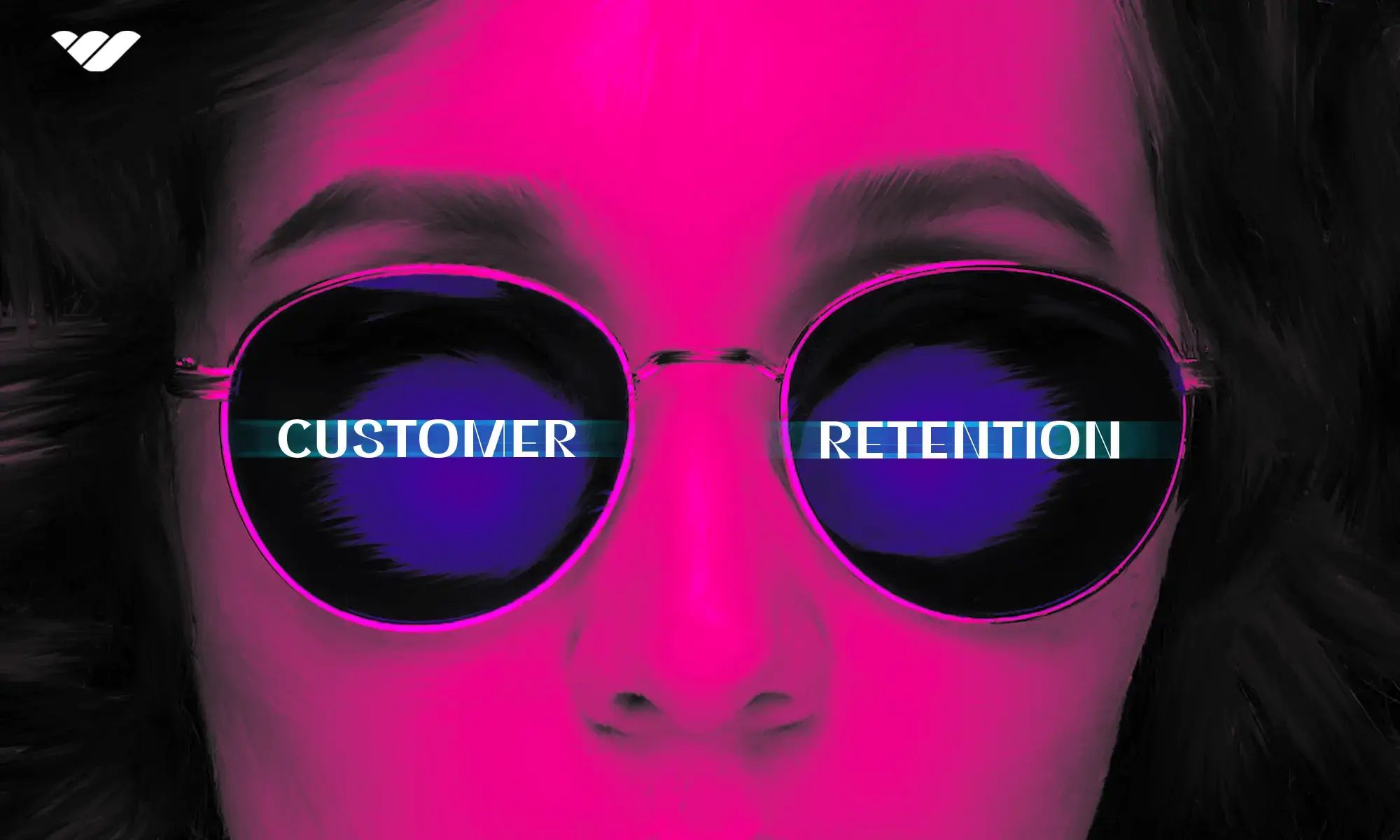It’s often suggested that growth is the only thing that matters in SaaS, but that couldn’t be further from the truth. While customer acquisition and growing your customer base are definitely important, keeping your customers for the longest possible amount of time may be even more so. It is their recurring subscription payments that keep your revenue rolling in.
Therefore, it is extremely important to focus on customer retention in SaaS. Plus, optimizing your SaaS retention metrics will take the pressure off your marketing and sales operations by establishing a solid revenue base.
So, this guide will look at customer retention in greater detail, and nail down the 12 key SaaS retention metrics you need to look at. We will even dive into how to interpret SaaS retention metrics, and how you can apply them to your business!
The Importance of Tracking Customer Retention
SaaS businesses tend to use subscription-based revenue models, which are great for cash flow but can easily be disrupted. Customers that you acquire pay you their subs each billing period. So, when you lose a customer, you also lose out on revenue. Not just for that period, but most likely in perpetuity. Once a customer has made a decision to cancel their subscription it can be difficult to win them back.
On the other side of the coin, a customer that sticks with you also does so with far less persuasion (aka expenditure of resources via marketing) than is required to acquire a new customer. Retaining a customer may come with a cost, but that cost is assuredly far less than the cost of acquiring new ones.
Your long-term customers are also likely to be the ones upgrading their plans, too. They’re more likely to pick up your add-ons and generally spend more than brand-new customers.
So, anyone who tells you that customer retention is costly and pointless is doing you a massive disservice. Focus on retaining your customers and delighting them instead, and you’ll not only see your revenue stabilize but grow. Plus, those happy customers might become enthusiastic supporters, spreading the word of your business for you!
Applying SaaS Metrics to Your Business
Before looking at the most important SaaS retention metrics, it’s equally as important to remember that your business is what matters, and some metrics may play less or more of a role depending on the current situation of your business and which stage it’s in. In other words, not all retention metrics are as important for every SaaS business.
Therefore, you should look at the metrics through the lens of your own business model. For example, the period used to calculate many of these metrics may differ based on your model—many SaaS businesses collect subscriptions on a monthly basis. If that’s the case, the period you’ll use to calculate your metrics will be a calendar month. On the other hand, if your business tends toward annual subscriptions, by all means, use a calendar year instead.
12 Key Metrics to Measure Customer Retention📈

Without further ado, let’s look at 12 key metrics that you can measure retention with, how they impact your business, and what insights they give you. These haven’t been picked in order of importance, and as mentioned previously, the stage your business is in and your current strategies may dictate which of these to prioritize.
#1. Customer Retention Rate
Customer retention rate is perhaps the most important key metric. It measures exactly what percentage of your existing customers are staying with you across a given period. It can serve as a good litmus test as to whether your current strategy or approach meets with the general satisfaction of your customers.
In order to calculate your customer retention, the first thing to do is identify what sort of time period you’re looking at. Once your period is set, find out how many customers you had at the end of the period and subtract the number of acquisitions in that time. Then divide by the number of customers you had at the start of the period.
A 100% score here shows you that you didn’t lose any customers at all over the period! This is the ideal score as far as retention is concerned. In reality, you might not hit 100% every month (or even get anywhere close to it) but you can easily benchmark yourself by looking at the retention rates of other similar SaaS companies.
Improve retention by delighting your customers, communicating with them regularly, and providing best-in-class customer support that’s available around the clock every day of the year. Check out Whop to take advantage of its 24/7 customer support with a 97% satisfaction rate!
#2. Customer Churn Rate
Customer Churn Rate is extremely close in concept to customer retention rate because it looks at how many customers you’ve lost across a given period. In essence, it’s nothing more than the inverse of retention, but it can give you a lot of added value.
For one thing, churn can actually be divided into active and passive churn. With the former, you’re looking at customers who make a conscious decision to cancel their subscription, while the latter refers to involuntary cancellations such as failed transactions and expiring credit cards.
By looking at your churn rate in this manner, you can take action to boost your retention in different ways. The implementation of an exit survey, for example, might help you better identify and isolate the reasons why customers are actively churning. This, in turn, may help you step in and fix any problems faster. By the same token, passive churn can be identified and reduced using measures such as dunning management.
Using a robust SaaS subscription management software might help you bring down your churn rate. For more info on how to choose the right software, check out our guide to the best SaaS subscription management software options.
#3. Revenue Churn Rate
At first glance, revenue churn rate may seem similar on the surface to customer churn rate. But there is a small difference, one which can add a lot of value to your analysis. By definition, revenue churn rate measures the percentage of revenue lost due to churn from one period to the next. Same thing, right? Actually, not at all!
To highlight the difference and how revenue churn rate shines, imagine a period where you have low customer churn rate and high revenue churn rate. This can happen if you offer different plans or tiered subscriptions. What the numbers are telling you is that you aren’t losing too many customers, but those that churn were from higher tiers or more expensive plans.
So, revenue churn rate can paint an extremely accurate picture of which customers you’re losing or retaining, compared to customer churn rate and customer retention rate which both treat all subscribers the same. How you act on this information will depend on your approach and strategy, but the value of this SaaS KPI lies in the fact that it gives you the ability to do so in the first place.
It’s extremely hard to stop a customer from canceling their plan once they’ve decided to do so, but remember that you still have options. Whop, for instance, gives you the facility to offer a canceling customer a one-time discount offer if they initiate cancellation. This won’t work in every case, but it could help you retain a few customers who might otherwise proceed with cancellation.
#4. Renewal Rate
Renewal rate is a SaaS KPI that measures the percentage of your customers who renew their subscription following the expiry of their previous contract. You can calculate it by dividing the number of expiring contracts in a period by the number of customers who completed renewal in that time.
The ideal renewal rate very much depends on the nature of your SaaS business, but generally, the more customers who renew, the better. Ensure that this is as high as possible by choosing a good SaaS subscription management platform, especially if you have a lot of customers. Communicating with a high number of customers at the right time in this manner is difficult. Automating the process helps!
#5. Customer Lifetime Value (LTV)
Customer lifetime value, abbreviated either as LTV or CLV, is an extremely important SaaS KPI in general. It is also very applicable to retention. To calculate LTV, multiply the value generated per customer by the length of their lifespan as a customer.
You’ll immediately notice that one of these factors relates directly to retention. If you can’t retain customers for a long time, your lifespan goes down, and your LTV will naturally be low. So, right off the bat, a low LTV compared to other similar businesses may indicate that your retention isn’t where it should be.
Tracking LTV over time is also a great idea because trends can give you some extremely useful information. Decreasing LTV, for instance, could flag a gradual reduction in customer lifespan. Alternatively, it could tell you that you’re acquiring and retaining low-value customers. As such, any sort of trend in LTV can flag your attention, and in conjunction with other metrics can give you some valuable insights that you can act on.
#6. Customer Acquisition Cost (CAC) & Months to Recover CAC
Customer acquisition cost and metrics related to it, such as months to recover CAC, tend to fall under the acquisition metrics umbrella rather than retention. Still, they can give you some crucial retention-related information.
CAC is all about how much of your resources go into acquiring customers. Months to recover CAC then tells you how long it takes you for a customer to generate enough revenue to recoup that cost, effectively giving you an ROI-like figure on your marketing and sales activities.
The real value of these metrics comes when you compare them to your LTV, which we went over in the previous section. You can learn a lot when comparing CAC and LTV—if your CAC is greater than your LTV, for instance, you’re seeing a huge red flag since the numbers are telling you that you’re spending more on acquiring customers than the entire revenue they pay you across their lifetime.
The CAC:LTV ratio is therefore a crucial one, showing you the effectiveness and sheer profitability of your model at least when it comes to expenditure on acquisitions. Crucially, looking at this ratio and how many months it takes to recover CAC gives you a great idea of your own retention goals. Using this information, you will know how long you need to keep customers in order to break even on them and be able to set other retention thresholds or benchmarks for yourself.
#7. ARPU & ARPA
Average revenue per user (ARPU) and average revenue per account (ARPA) are both useful metrics to look at when considering retention. They’re similar metrics in concept, but depending on your SaaS business’ client profile they may be quite different.
The difference between these two KPIs lies in the fact that your SaaS business may have companies as clients. These companies, in turn, may have several of their employees using your software. The number of users is captured by ARPU, while ARPA would consider that corporate client as a single account.
Tracking ARPA and ARPU over time can be very helpful since they can give you an indication of your growth trajectory. Increasing ARPU especially can suggest that the customers you successfully retain are increasing in value through upgrades, purchasing add-ons, and repeat purchases of your products.
#8. Net Revenue Retention (NRR)
Net revenue retention (NRR) gives you an excellent indicator of your retention by measuring the percentage of revenue retained from existing customers over a given period. This ignores revenue from new customers, so it can isolate your retention revenue nicely.
To calculate NRR, calculate the revenue from existing customers at the end of a period and divide it by the recurring revenue from those same customers at the beginning of the same period. If you end up with a result of less than 100%, you can see that churn is losing you revenue. If NRR is over 100%, your existing customers are increasing value beyond what churn is costing you, through upselling, cross-selling, and more.
This is an excellent perspective because it doesn’t just look at focusing on retaining customers but also on the potential to provide more value to your business over time through upselling, cross-selling, and upgrades.
A high NRR shows your ability to derive the maximum value from retention, and it’s one of the most highly sought-after SaaS metrics. Give yourself every chance to maximize your own NRR by signing up with Whop!
#9. Customer Concentration
Customer concentration might be a marketing or sales KPI on the face of it, but it can be very important to retention depending on the nature of your business model. The metric itself looks at how dependent your SaaS business is on a small number of high-value customers.
This can be an especially critical factor if your customer base includes only a limited number of corporate accounts, as it could well be that you have one or two clients whose business dwarfs that of all others.
While the benefits of this are apparent, it can also be a huge risk. However good the relationship may be between yourself and your major client, they could pull the plug at any time and with minimal warning. This could devastate your business overnight, especially if you don’t have enough cash reserves to survive the hit to your cash flow and revenue.
Customer concentration therefore is an indicator of how important retention is and gives you an idea of where you should be focusing your retention efforts.
#10. Expansion Rate
Expansion rate, sometimes called existing customer growth rate, can help you alongside the previously mentioned net retention rate metric. It drills down into how much revenue your existing customers are adding through upgrades, cross-sells, add-ons, and more.
Expansion rate is the sum of all of these purchases, and it shows you the value of customer loyalty and retention in action. You can also analyze expansion rates across different customer segments, which in turn might lead you to focus your retention efforts in one particular area over others.
#11. Customer Health Score
Customer health score isn’t a standardized metric, but many SaaS businesses find themselves building a bespoke solution due to the value that it can bring. The general idea is to keep a finger on the pulse of your customers’ relationship with your business and know where you stand with your customers.
The goal of having a KPI like a customer health score is to be able to predict the likelihood of renewal and churn, and thus have the ability to act on the latter proactively. It’s much more likely that you can repair the relationship with a customer before they decide to cancel than after.
Building a customer health score metric is tricky but certainly not impossible. It’s up to you to decide what information or pieces of data can help you work out where a customer is on the loyalty and satisfaction scale at any given point in time. Once you have some different variables selected, you can weigh them and start tracking things over time.
#12. Net Promoter Score (NPS)
Net promoter score is a customer satisfaction metric that naturally bears a positive relationship with retention—it stands to reason that the happier a customer is with your service and the more likely they are to recommend it, the more likely they also are to remain a customer for longer.
This SaaS metric is generally measured via a customer feedback survey, attempting to group your customers into “detractors”, “passives”, and “promoters” based on their willingness to recommend you to others.
Using this information, you can assume that those who are happy with your service and willing to recommend it will also stay with you. Plus, it’s possible to attach a risk of churn to customers identifying as detractors. As such, NPS is something of an early warning system that you can use to nip the problem in the bud, by communicating with those customers and trying to address the cause of their dissatisfaction.
Tracking NPS over time can also give you an idea of what your churn or retention rates are likely to be, since any sort of change in trajectory or establishment of a trend gives you a clue as to where your overall customer sentiment is heading. For that reason, it’s an extremely valuable metric in several ways.
Choose Whop to Boost Your SaaS Retention!
As our detailed list suggests, tracking, measuring, and optimizing the customer retention of your SaaS business isn’t a task taken lightly. There are many different SaaS KPIs to help you isolate different aspects of your business that affect retention. By using these metrics, you can derive plenty of high-value insights and act on them decisively to keep your best customers with you for longer.
None of this is possible without the right set of tools, however. From being able to measure all of these metrics in the first place to act on them in an efficient, effective manner, you need the right subscription management system by your side. This is where Whop comes in!
👉 Whop’s subscription management solution is easy to set up and layers on features that will help you every step of the way, from tiered plans, coupon codes and discounts; to cancellation offers, dispute resolution and real-time financial metrics and analysis. With 24/7 customer support, Whop can help you take your SaaS business to the next level. Visit Whop now and talk to the team to get started!



![The Best SaaS Subscription Management Software [2024]](/blog/content/images/size/w600/2023/11/SaaS-management.webp)

